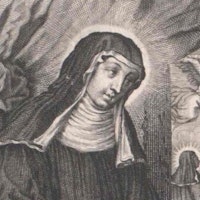Divinity is in its omniscience and omnipotence like a wheel, a circle, a whole, that can neither be understood, nor divided, nor begun nor ended.
Hildegard of Bingen

Like a Circle
Topic: The Natural World
A wheel was shown to me, wonderful to behold. Divinity is in its omniscience and omnipotence like a wheel, a circle, a whole, that can neither be understood, nor divided, nor begun nor ended… just as a circle embraces all that is within it, so does the Godhead embrace all.
Hildegard of Bingen (1098-1179) was a Benedictine abbess and mystic of medieval Germany. She was born into a noble family in Bermersheim vor der Höhe, Germany, and entered religious life at the age of eight. She received a rudimentary education, but at the age of forty-two, she began to experience a series of visions that would shape her life and work.
Hildegard described these visions as "the living light," and they were often accompanied by physical sensations such as heat, cold, and pain. She believed that these visions were a gift from God, and she felt called to share them with the world. She began to write down her visions, and she also composed music and poetry to express her spiritual insights.
Hildegard was a prolific writer, and her works cover a wide range of topics, including theology, natural science, medicine, and music. She is best known for her three volumes of visionary theology: Scivias, Liber Vitae Meritorum, and Liber Divinorum Operum. These works are rich in symbolism and imagery, and they offer a unique perspective on the nature of God, the human soul, and the world.
In addition to her writings, Hildegard was also a gifted musician and composer. She wrote over 70 songs, including the Ordo Virtutum, an early example of liturgical drama. Her music is characterized by its simple melodies and its use of plainchant.
Hildegard was a complex and multifaceted figure, and her work continues to inspire and challenge people today. She was a visionary, a mystic, a writer, a composer, a scientist, and a healer. She was also a woman of great courage and determination, and she used her gifts to make a difference in the world.
Hildegard of Bingen was a remarkable woman who left a lasting legacy. She was a pioneer in the fields of theology, natural science, and music, and her work continues to be studied and appreciated today. She was also a powerful voice for women's rights, and she challenged the patriarchal structures of her time. Hildegard of Bingen was a true visionary, and she continues to inspire us with her courage, her intellect, and her creativity.
Bingen, Hildegard of [Fox, Matthew. Illuminations of Hildegard of Bingen. Simon and Schuster.]

Hildegard of Bingen
Theme: Natural World

About This Hildegard of Bingen Quotation [Commentary]
Hildegard of Bingen describes a vision in which “a wheel was shown to me, wonderful to behold.” This wheel becomes a living symbol of the divine: “Divinity is in its omniscience and omnipotence like a wheel, a circle, a whole, that can neither be understood, nor divided, nor begun nor ended.” The image emphasizes a wholeness that is uninterrupted, without edges or breaks—a form that resists linear interpretation. Hildegard does not offer a theological abstraction but an image drawn from movement and unity, inviting recognition of the divine as a presence that holds together all existence.
She continues: “just as a circle embraces all that is within it, so does the Godhead embrace all.” The language of embrace and wholeness carries maternal overtones, reinforcing the understanding of God not as remote power, but as a presence that gathers and includes. The word “Godhead,” feminine in Hildegard’s Latin and German, reinforces this encompassing quality. The divine is not fragmented or partial but is complete and all-enfolding, much like the interconnected patterns found in the natural world.
In this vision, the unbroken circle is both mystery and measure. The divine “can neither be understood, nor divided,” reminding us that, like nature itself, the sacred exceeds full explanation. Hildegard’s wheel reflects more than divine shape—it reveals a divine motion that continues without pause, without beginning or end. The natural world, with its rhythms and interdependence, mirrors this form. What is shown to her is not a doctrine to be dissected but a vision to be received: the divine as a whole that embraces all.
Hildegard of Bingen [Commentary by Matthew Fox]
Hildegard understands this mandala to represent the Divine Trinity. “One light, three persons, one God,” she declares. It is important to Hildegard that God be imaged essentially as curved and circular. This is an ancient tradition wherever women’s religions are allowed their say: the Divinity as circle, or circle in motion, that is, spiral. Hildegard writes elsewhere: “A wheel was shown to me, wonderful to behold. Divinity is in its omniscience and omnipotence like a wheel, a circle, a whole, that can neither be understood, nor divided, nor begun nor ended.” And again, “just as a circle embraces all that is within it, so does the Godhead embrace all.”
The imagery of God as circle, God that embraces all, that encompasses all, is deeply maternal. “Godhead,” which is feminine in both Latin and German, is an all-embracing name for divinity. We celebrate here the curved and all-encompassing power of God. Yet we also celebrate God’s nearness, for Hildegard also says: “God hugs you. You are encircled by the arms of the mystery of God.” Thus God’s power is not an abstract power or a vengeful power but a maternal, loving, and deeply personal power. It is a compassionate power. This power cannot in the long run be excluded from our lives or from our universe. For “no one has the power to divide this circle, to surpass it, or to limit it.”
Additional Hildegard of Bingen Quotes
Resources
Related Quotes
Copyright © 2017 – 2025 LuminaryQuotes.com About Us